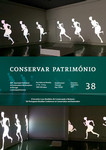 |
Elisabete Ferreira, António João Cruz, Carla Rego, "Intervenção nas pinturas maneiristas sobre madeira representando São Sebastião e Santa Luzia, de Belchior de Matos, constituintes de um díptico da ermida de Geraldes, em Peniche", Conservar Património, 38, 2021, pp. 49-57, doi:10.14568/cp2020051 |
|
⯇ | ⯈
|
| Resumo |
Os painéis representando o Martírio de São Sebastião e Santa Luzia, executados depois de 1610 pelo pintor Belchior de Matos para o retábulo-mor da ermida de São Sebastião e Santa Luzia, Geraldes, concelho de Peniche, foram sujeitos a intervenção de conservação e restauro que teve como principal objectivo restituir-lhes a dignidade indispensável à sua adopção pela comunidade e à sua recolocação num espaço de culto. As obras apresentavam vários danos, mas os mais graves eram os problemas estruturais que colocavam em causa a sua estabilidade e comprometiam o valor estético das pinturas. Por isso, foi necessário proceder-se à reensamblagem das tábuas, usando-se um adesivo sintético (PVA) com carga de serradura e microesferas de resina fenólica. As molduras, com significativas faltas de material lenhoso, foram reconstituídas com madeira na zona dos encaixes e com pasta de preenchimento (Araldite SV427) sobre estrutura de cavilhas de bambu nas calhas onde entram os suportes. |
| Title |
Intervention in Mannerists wooden paintings representing Saint Sebastian and Saint Lucy, by Belchior de Matos, constituents of a diptych of the chapel of Geraldes, in Peniche |
| Abstract |
The panels of Martyrdom of Saint Sebastian and Saint Lucy, executed after 1610 by the Portuguese mannerist painter Belchior de Matos for the main altarpiece of the chapel of Saint Sebastian and Saint Lucy of Geraldes, Peniche, were subject to an intervention of conservation and restoration which aimed, in the first place, to restore the dignity indispensable to their adoption by the community and to their return to a place of worship. The works had several damages, but the most serious were the structural problems that jeopardized their stability and compromised the aesthetic value of the paintings. Therefore, it was necessary to reassemble the boards using a synthetic adhesive (PVA) with sawdust and phenolic resin microspheres. The frames, with significant lack of wood, were reconstituted with wood in the joints and with a filler paste (Araldite SV427) over a bamboo dowels structure in the grooves where the supports are inserted. |
| Editora |
URL |
| Ver |
PDF |
| |
Academia | Researchgate |
| Importar |
RIS | Endnote |
